
How I manage my health data
Key takeaways:
- Organizing health records enhances decision-making and provides quick access to important medical history.
- Tracking health data fosters empowerment, accountability, and better communication with healthcare providers, leading to improved care.
- Choosing the right health apps should focus on user-friendliness, customization, data privacy, integration, and community support.
- Analyzing health trends can reveal vital connections between lifestyle choices and overall well-being, guiding informed decisions for improvement.

Understanding health data management
Health data management is crucial for making informed decisions about my wellbeing. I’ve found that being organized with my health records not only helps me track progress but also allows me to address potential issues before they escalate. Isn’t it reassuring to know that I can have quick access to my medical history when needed?
I remember the first time I faced a medical issue and didn’t have my records at hand. The frustration of sitting in a waiting room, unable to provide my history accurately, made me realize the importance of having my data organized. Now, keeping everything from lab results to vaccination records in one place offers a sense of control and peace of mind.
Managing health data goes beyond just storage; it’s about understanding the metrics that matter to me. When I analyze my blood pressure readings over time, I can see patterns that inform my lifestyle choices. This proactive approach transforms numbers on a page into tangible insights about my health, making the whole process feel empowering. Don’t you think there’s a certain strength in navigating our own health information?
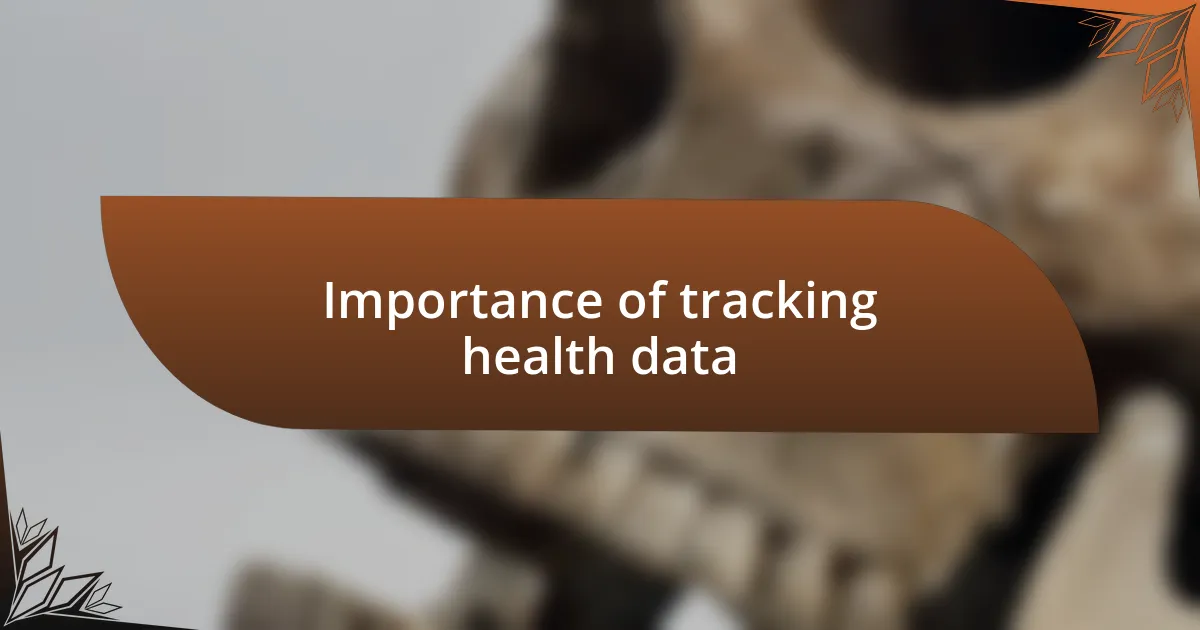
Importance of tracking health data
Tracking health data is essential for several reasons. Firstly, it empowers me to take charge of my health narrative. By monitoring my daily habits, I can identify trends and correlations that impact my wellbeing. For instance, when I recently noticed that my sleep quality affected my stress levels, I adjusted my routine, leading to significant improvements in both areas.
Another crucial aspect is the facilitation of better communication with healthcare providers. I once attended an appointment and handed over a detailed overview of my medication history and lifestyle changes. The look on my doctor’s face was priceless; it streamlined our discussion and allowed me to receive targeted advice, ultimately enhancing my care.
Moreover, tracking health data can foster a sense of accountability. When I committed to a fitness goal, charting my progress not only motivated me, but it also brought clarity to my journey. I recall celebrating small wins, like the day I hit my step goal consistently for a month. Those moments made the effort worthwhile and kept me engaged in my health journey.
| Benefits of Tracking Health Data | Impacts on My Health |
|---|---|
| Empowerment | Better ownership of my health decisions |
| Communication | Enhanced discussions with healthcare providers |
| Accountability | Motivated to pursue my health goals |
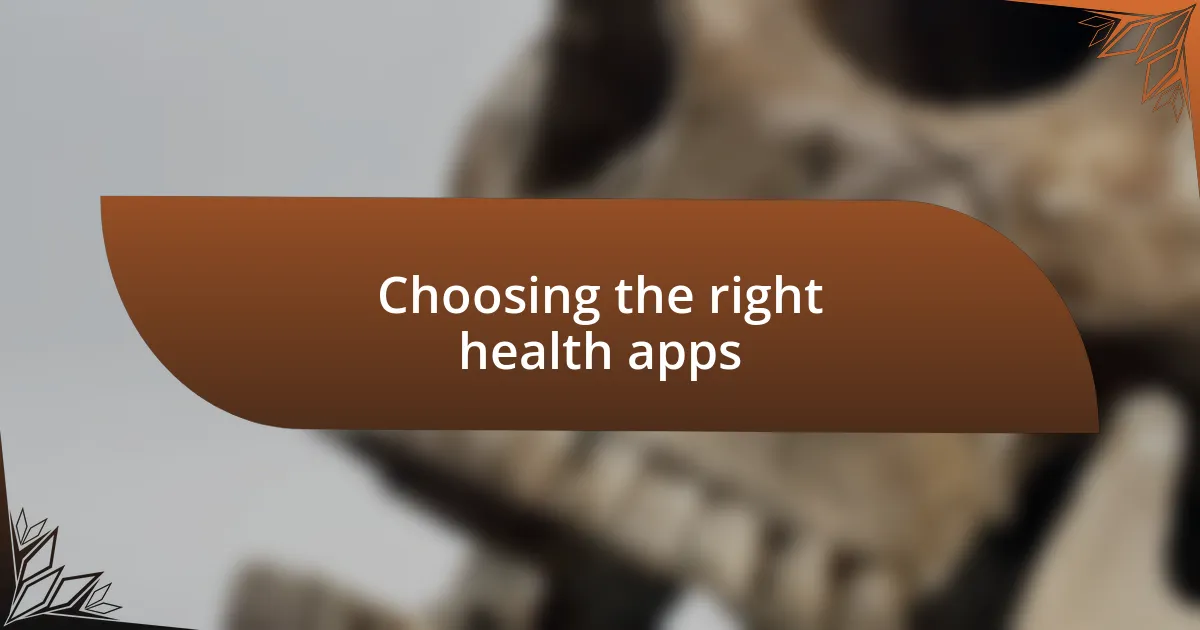
Choosing the right health apps
Choosing the right health apps can feel overwhelming, especially with the plethora of options available. I remember the early days when I downloaded just about every fitness app I could find, hoping something would stick. After some trial and error, I realized that finding the right app hinges on understanding my individual needs. Are you looking to track nutrition, exercise, or maybe mindfulness? Pinpointing your core goals helps narrow down the choices significantly.
Here are some key factors I consider when selecting health apps:
- User-Friendly Design: I strongly prefer apps that are intuitive and easy to navigate. Complex interfaces can be discouraging.
- Customization Options: I appreciate apps that allow me to tailor features based on my unique health goals.
- Data Privacy: I always check how my data is stored and shared. Protecting my health information is a top priority.
- Integration with Other Devices: If an app syncs with my smartwatch or fitness tracker, it saves me time and enhances my overall experience.
- Community Support: Having access to a community or support system within an app can be incredibly motivating. I’ve found that sharing progress and challenges with others makes my journey more enjoyable.
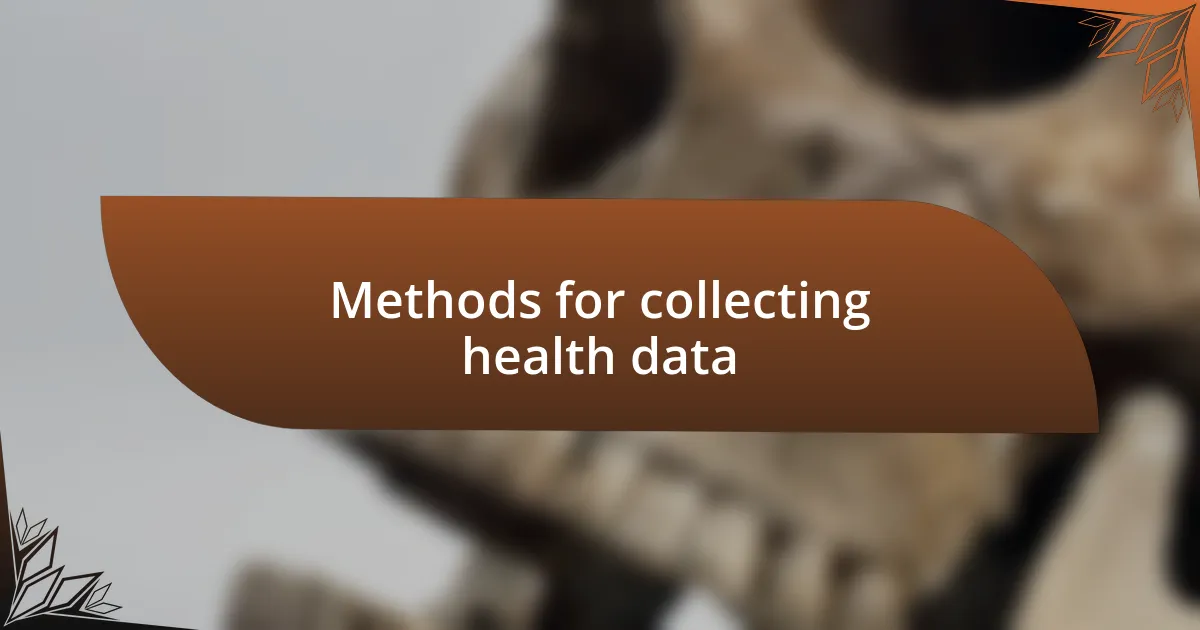
Methods for collecting health data
When it comes to collecting health data, I often turn to wearables like fitness trackers. These devices automatically log my steps, sleep patterns, and heart rate, providing an easy way to monitor my activity levels without much effort on my part. Have you ever been surprised by how little you move in a day? I know I have. The insights I gain from tracking my movement help motivate me to be more active.
Surveys and self-reported data are also vital in my arsenal. I’ve found that taking a few minutes each week to fill out a questionnaire about my eating habits and mood can reveal patterns I might otherwise overlook. For example, I realized that my snack choices sometimes correlate with stressful days at work. This simple practice has been an eye-opener and has encouraged me to adopt healthier routines.
Lastly, using health apps for regular check-ins and logging symptoms is something I can’t recommend enough. There’s something therapeutic about documenting how I feel physically and emotionally. It not only helps me track my progress but also assists my healthcare provider in understanding my health journey better. Have you tried keeping a daily health journal? It’s not just about data; it’s about creating a narrative of your health experiences that can be incredibly valuable.
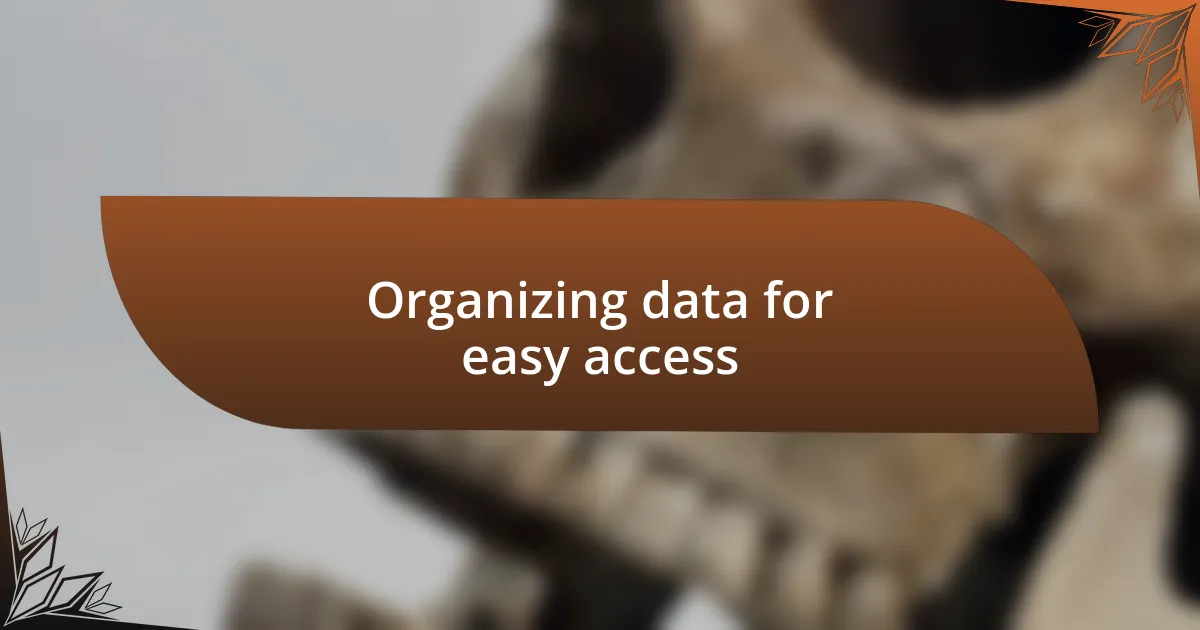
Organizing data for easy access
Organizing my health data in a way that is easy to access has transformed how I manage my well-being. I’ve created a simple system that categorizes my information into three main areas: fitness metrics, dietary habits, and emotional wellness. By having everything in one central location, I can quickly pull up details during my check-ins with healthcare providers, which makes our conversations more productive. Have you ever felt unprepared at a doctor’s appointment? I certainly have, and it’s a frustrating experience.
Another strategy I use is color-coding my spreadsheets and notes. For me, green represents positive changes, like days when I meet my exercise goals, while red highlights areas that need improvement, such as days I skip healthy meals. This visual representation not only keeps me accountable but also gives me a quick overview of my health journey at a glance. I find it satisfying to see the balance between the two colors gradually shifting more towards green. Doesn’t that sound more motivating than a plain list?
I also rely on digital tools, such as apps that allow me to sync my data across devices. With everything backed up in the cloud, I can access my health data from anywhere, whether it’s my phone or laptop. A few weeks ago, while waiting for a flight, I used my app to review my sleep patterns and made a quick decision to adjust my bedtime for better rest the following night. It struck me then how powerful it is to have my health information at my fingertips; it allows me to make informed choices even in the most unexpected situations. Have you experienced that feeling of empowerment from easy access to your health data? It’s a game-changer.
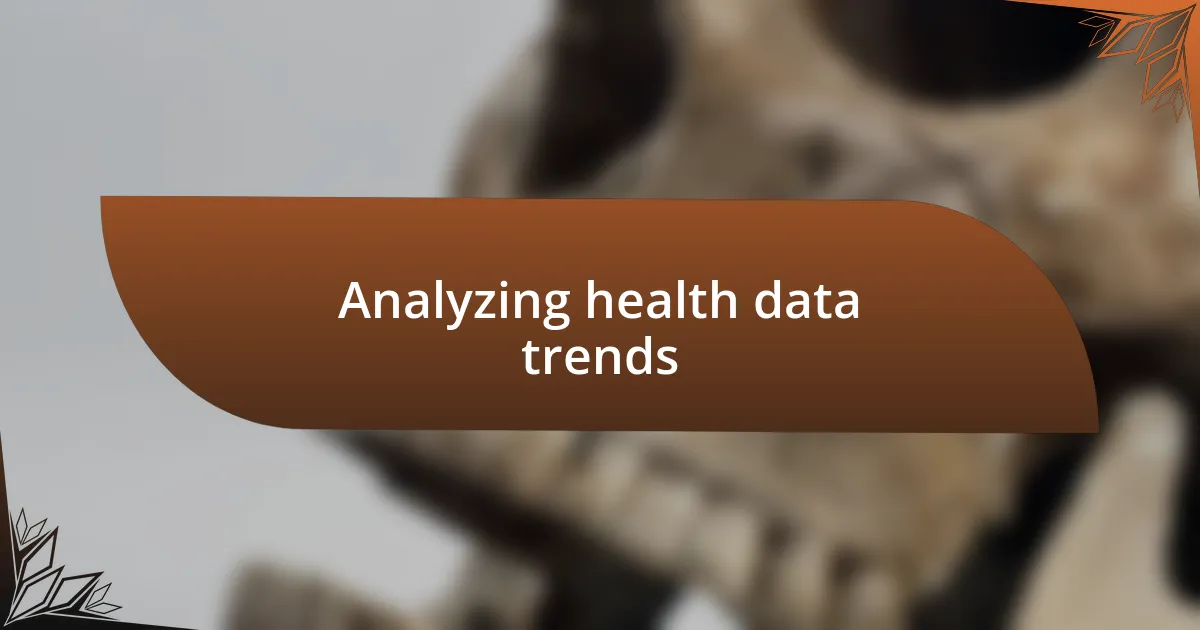
Analyzing health data trends
Analyzing trends in my health data brings clarity and insight into my overall well-being. For instance, when I noticed my weekly step count steadily decreasing over a month, it prompted me to reevaluate my routine. I realized that a new work schedule was cutting into my walking time, which led me to incorporate walking meetings. Have you ever had a similar realization that changed your habits for the better?
One of the most eye-opening moments for me was tracking my mood alongside my dietary habits. I discovered that on days when I consumed more whole foods, my emotional state was markedly better. This connection inspired me to dive deeper into not just eating healthy but understanding how my choices affect my feelings. Isn’t it fascinating how intertwined our nutrition and mental health can be?
I also find it helpful to create visual graphs of my health data over time. Seeing the upward trends in my fitness levels right next to my improved sleep hours creates a motivating picture. Just last week, I reviewed a month’s worth of data and was thrilled to see my exercise consistency pay off. Have you considered how visually representing your data could help motivate you? Each peak and trough tells a story that can guide your next steps.
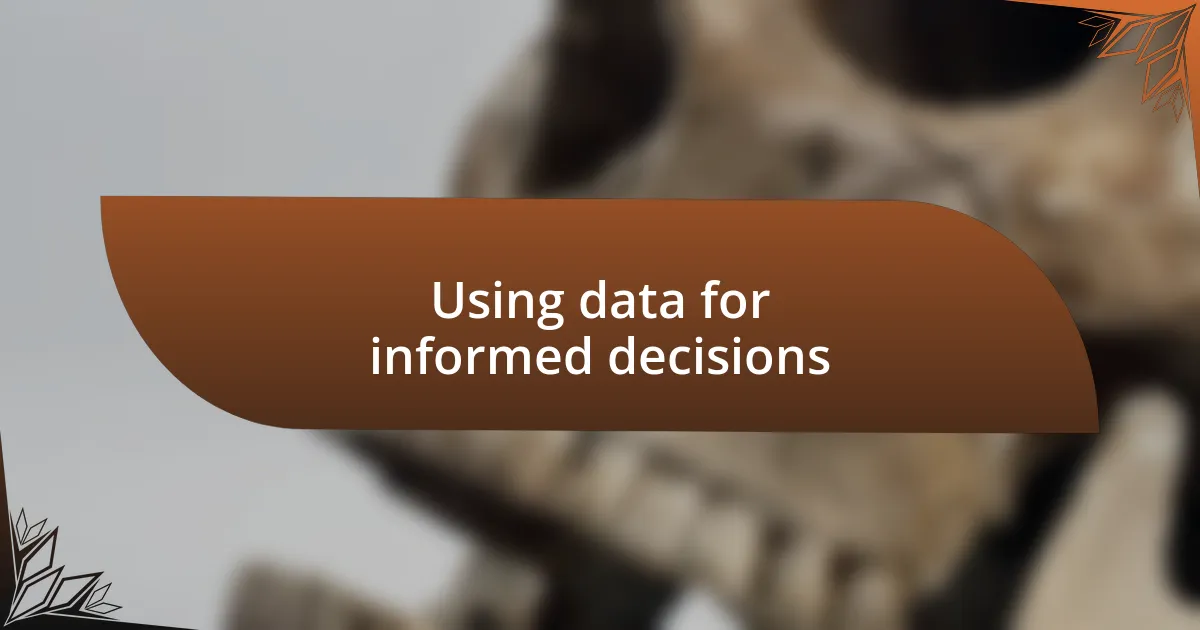
Using data for informed decisions
Using data for informed decisions has been a game changer for me. For instance, tracking my sleep patterns revealed that a few late-night snacks disrupted my rest, something I hadn’t connected before. Adjusting my evening routine not only improved my sleep quality but also brightened my mornings—have you noticed how little changes in habits can lead to significant improvements in your day?
I also found that comparing my energy levels with my physical activity data offered profound insights. On days I exercised earlier in the day, my productivity soared. It was a revelation to realize that a simple morning jog didn’t just contribute to my fitness; it also set a positive tone for my entire day. Have you ever considered how exercise timing could influence your overall performance?
Sometimes, making sense of the data feels overwhelming, like trying to decipher a complex puzzle. However, breaking it down into manageable pieces has proven effective for me. I target one variable at a time, like hydration levels, and evaluate its impact over a couple of weeks. This focused approach has clarified what adjustments yield the best results. How do you tackle your data analysis to ensure you’re making informed choices?


